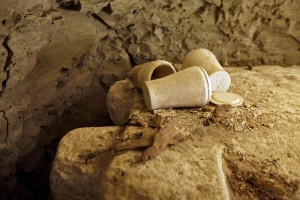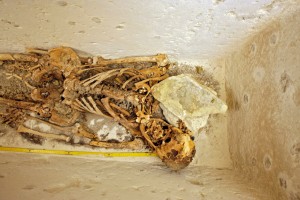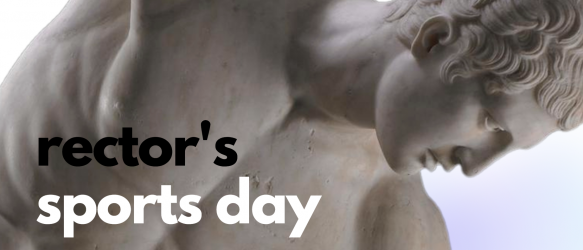Since March this year, archaeologists of the Czech Institute of Egyptology, Faculty of Arts, Charles University in Prague have been working in the southern part of the Institute´s archaeological concession in Abusir, near Cairo.
The research team is now busy analysing the unique archaeological discoveries unearthed last year. Last year´s season peaked with the discovery of the mastaba belonging to Shepseskaf-Ankh, the chief physician in Upper and Lower Egypt. This discovery was named the world´s sixth most important archaeological discovery for 2013 by the journal Heritage Daily.
Sealed sarcophagus of a high official from the 2nd half of the 5th dynasty (image © Martin Frouz, archive of the Czech Institute of Egyptology, CU FA).Furthermore, the team has been excavating the adjoining underground tombs. One of the shafts revealed an untouched burial chamber of a high official from the second half of the 5th dynasty, whose name is yet to be determined. The room is dominated by a huge limestone sarcophagus; a wooden box, located at the southern corner of the sarcophagus, contained four stone canopic jars for storing mummified organs.
On 19 March, the burial chamber and the sealed sarcophagus were opened under tight security measures, in cooperation with officials from Egypt´s Ministry of Antiquities and its staff from the Antiquities Inspectorate of Sakkara. The sarcophagus contained the body of an older man, lying stretched out, richly decorated with faience and holding a stick, which symbolizes his status. The body shows signs of having been mummified and is to be analysed by experts from the National Museum in Prague in the following weeks. The unharmed skeleton is a welcome contribution to the research into the anthropology and living conditions of the population of the then capital, Memphis, in the 3rd millennium BC. Beyond any doubt, the remains are those of a prominent member of a family of royal officials, one of whom was married to the Pharaoh´s daughter, Sheretnebty (her tomb, located in the vicinity of the present find, was uncovered by members of the Institute in 2012).
The discovery was made in the compound of a high official, Nefer, who lived in the 24th century BC. With research in this part of the archaeological concession in the south of Abusir still to continue, more discoveries can be expected. This is more evidence that Czech Egyptologists, who have seen drastic reductions in their funding in recent years, rank among the world´s top researchers.

Limestone canopic jars for storage of organs belonging to a high official from the 2nd half of the 5th dynasty (image © Martin Frouz, archive of the Czech Institute of Egyptology, CU FA).

Skeletal remains of a high official from the 2nd half of the 5th dynasty (image © Martin Frouz, archive of the Czech Institute of Egyptology, CU FA).







